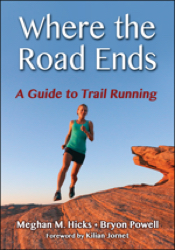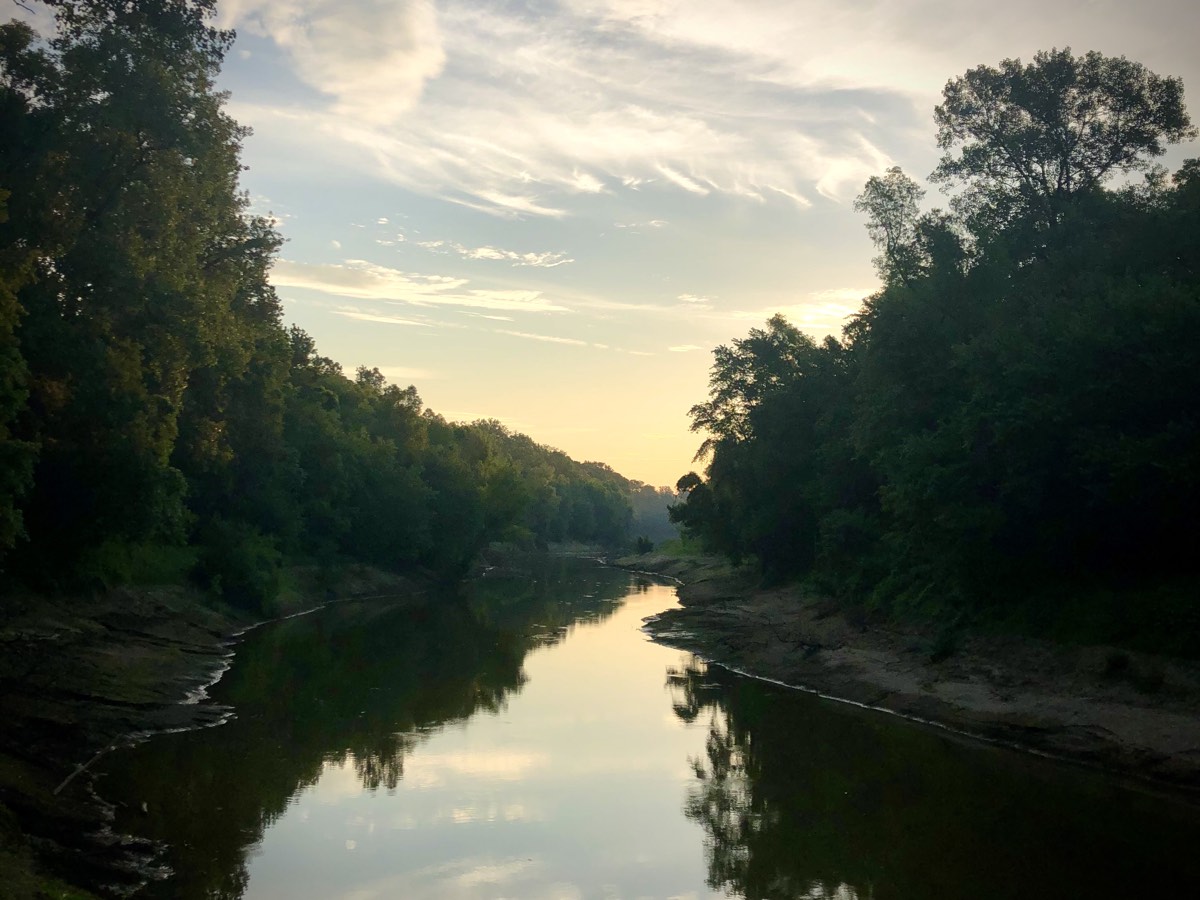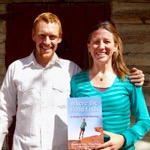
If you enjoy this article, then get your own copy of the book “Where the Road Ends!”
Welcome to this month’s edition of “Where the Road Ends: A Guide to Trail Running,” where we share our guide on how trail runners can care for the trails upon which they run.
“Where the Road Ends” is the name of both this column and the book Meghan Hicks and Bryon Powell of iRunFar published in 2016. The book Where the Road Ends: A Guide to Trail Running is a how-to guide for trail running. We worked with publisher Human Kinetics to develop a book so anyone can get started, stay safe, and feel inspired on the trail.
The book teaches you how to negotiate technical trails, read a map, build your own training plan, understand the basics of what to drink and eat when you run, and so much more. This column aims to do the same by publishing sections from the book, as well as encouraging conversation in the comments section of each article.
In this article, we excerpt from Chapter 10. Most trail runners share a common motivator: the desire to experience and move through natural landscapes. We take to the trails for their clean air and water, abundant and healthy wildlife, diversity of plant life, quiet, lack of human impact, aesthetic vistas, and more.
These resources are, in some cases, sensitive and rare. And these resources, in all cases, are finite. Impact by humans can and does change, damage, and destroy them.
It’s a privilege for us trail runners to be stewards of the lands through which we run. Land stewards believe that all of the resources in a landscape as well as the people who use those places should be carefully cared for. Thus, our goal as trail runners is to travel with care, thereby minimizing the impact we have on natural spaces. As they say, knowledge is power, so this article offers the basic framework for responsible trail running.
The Leave No Trace Center for Outdoor Ethics (LNT), a nonprofit organization that promotes land stewardship in everyone who recreates outdoors, developed seven core principles to help guide outdoor recreation of all kinds, including trail running:
- Plan Ahead and Prepare
- Travel and Camp on Durable Surfaces
- Dispose of Waste Properly
- Leave What you Find
- Minimize Campfire Impacts
- Respect Wildlife
- Be Considerate of Other Visitors
© Leave No Trace Center for Outdoor Ethics: www.LNT.org.
The balance of this article applies these principles to trail running and discusses the many ways you can be a caretaker of the places through which you travel.

Trail runners are privileged to care for the wild spaces through which we run. Photo: Andy Jones-Wilkins
Preparation
The legwork of a trail run begins before you reach the trail. Natural areas are administered by towns, counties, states, the federal government, or private entities.
Each natural space has a unique set of rules designed by its land managers to protect and preserve its equally unique resources. That’s because different resources need to be differently cared for. Knowing the rules helps trail runners avoid behaving in a damaging way.
Here are a couple of rules commonly found in natural spaces that apply to trail running:
Opening and closing times. Sometimes this rule is established to give space to wildlife that is active nocturnally. Other times, this rule is in place because natural spaces aren’t staffed at night.
Group sizes. The larger the group, the more the impact that group will have on the environment and the other people also using it. Many land managers establish a maximum group size that is sustainable for a particular open space.
Another way that trail runners can plan ahead is to research the potential hazards and special qualities of natural spaces. Is there a certain type of wildlife to be watching for? Are there rare plants growing along the trail? Is the trail easy to follow or are there tricky intersections to navigate? Being prepared for the conditions you are about to experience will help prevent negative interactions.
Substrate Impacts
Walking and running on trails, next to trails, at overlooks along trails, and off trail can have a negative impact if the surfaces over which you travel degrade as a result of your footsteps. Examples of the nondurable surfaces you might encounter include mud, riparian areas, alpine environments, and cryptobiotic soil.
LNT asks that trail users travel single file, on trail, and down the middle of the trail, even if it’s muddy or wet. Walking along the trail margin or outside of the trail tread to avoid mud or water can cause the trail to widen and erode. In some deserts, land managers forbid off-trail travel to protect cryptobiotic soil, which can take decades to redevelop if damaged, and to prevent erosion.
As a trail runner, you are familiar with switchbacks, or the bends trails make on hillsides so that you don’t have to travel straight up or down that hill. Switchbacks are in place to prevent the erosion that would occur in a path that’s as steep as a hill. Please stay on the trail, even if you’re tired or trying to run fast.
Proper Waste Disposal
By waste, LNT means everything you bring with you or produce while trail running: the wrappers of the food you’re eating, leftover organic matter like apple cores and banana peels, and your body’s waste products.
In terms of the trash produced, it’s pack it in, pack it out. We additionally encourage you to pick up any trash you find that was left by someone else. The reasons for this are self-evident: Trash isn’t natural, it doesn’t easily biodegrade, animals that eat it can become sick, and it’s unsightly.
When it comes to bodily waste, always use a bathroom when it’s provided. Here’s trail runner and National Outdoor Leadership School instructor Liza Howard’s recommendation for dealing with your bodily waste on the trail, “The best practice is to walk about 70 steps from the trail or water, dig a hole about six inches deep and big enough to accommodate your deposit … and then fill the hole in and cover it up.”
LNT asks us to carry out all toilet paper and sanitary products. They take many years to degrade and, thus, should not be buried. Bring a couple of Ziploc bags to carry out these things.
Take Nothing, Leave Nothing
There are plenty of interesting objects that will capture your attention along the trail such as fossils, plants, historical artifacts, and more. LNT asks that you leave everything just as you found it.
Enjoy the heck out of whatever you find. Stop, take photos, and dream about what the world was like when the artifact was made, but leave the objects exactly as you found them.
LNT asks trail users to additionally leave natural places unaltered. Rock cairns and wind shelters, made by stacking rocks atop each other, for example, leave unnecessary, long-lasting, visible, and unnatural reminders of your visit.
Consideration for Wildlife
As previously discussed, wildlife roams in the places you trail run. Birds, insects, reptiles, ungulates, and predatory mammals call open spaces home. To see a herd of elk grazing in a meadow, to watch butterflies pollinate flowers, to hear frogs croaking from desert oases, or to hear a pack of coyotes yipping at sunset: a glimpse of wildlife living free is an incredible benefit of trail running.
It’s your job to make sure wildlife have the continued opportunity to live unbothered by your passage. Most importantly, give wildlife its space. A national-park ranger once gave us a wonderful recommendation for providing wild animals with the space they need to feel comfortable: If an animal modifies its behavior for you, you’re too close. Different land managers have a variety of rules and recommendations for how far you should stay away from certain kinds of wildlife.
Don’t feed animals and always supervise your food and hydration pack so that you don’t unintentionally provide wildlife access to your food. Wild animals can become sick from the consumption of human food. Access to human food additionally makes many animals behave aggressively as they attempt to gain access to more human food.
Dogs love to chase and, in some cases, kill wildlife. Control your pet at all times by leash or voice.

We trail runners have the responsibility to respect wildlife, like this mountain goat in Colorado. Photo: iRunFar/Meghan Hicks
Consideration for Other Visitors
Trail runners share the trails with all sorts of other human users, including other trail runners, hikers, dog walkers, mountain bikers, birders, backpackers, equestrians, hunters, off-road vehicle riders, motorcyclists, astronomers, and more. Each legal trail user has a right to experience the trail, and none should behave in a way that degrades another’s experience.
Most land managers for areas that are visited by multiple user groups have established rules to govern how these groups interact. Rules establishing right-of-way designations, one-way trails, limited-use trails, trails where motorized use is allowed, trails where motorized use is prohibited, and more are meant to help prevent negative and dangerous encounters among user groups.
LNT asks trail users to respect other users’ desire for quiet. If you would like to listen to music while you run, use headphones, for example.
As previously mentioned, trail runners should control dogs so that other trail users don’t have to interact with them if they don’t want to.
LNT says that a trail user should keep courtesy and respect in mind each time they interact with other trail users, that this simple but mindful approach can effectively guide our actions in a way that will help sustain strong, kind relationships between all trail users.
Trail running in wild places is a privilege. Running with as little impact as possible on the resources through which you travel and the other trail users you meet ensures that our wild places stay wild.
Excerpted from Where the Road Ends: A Guide to Trail Running, by Meghan Hicks and Bryon Powell. Human Kinetics © 2016.
Call for Comments
- What specific recommendations can you offer that help trail runners protect the places through which they run?

